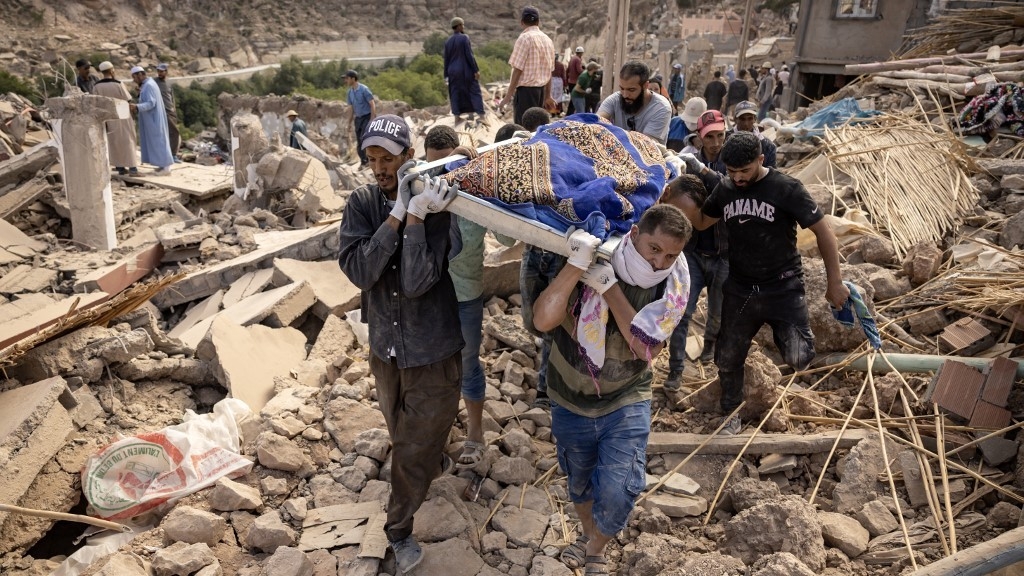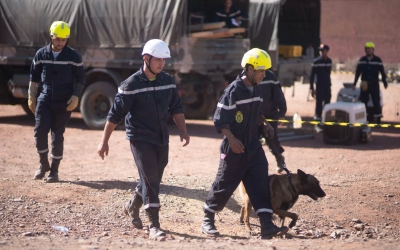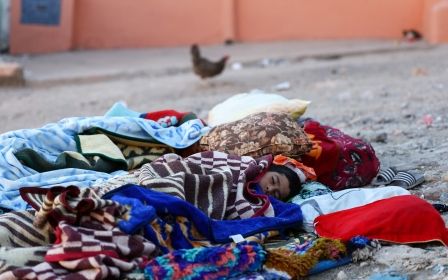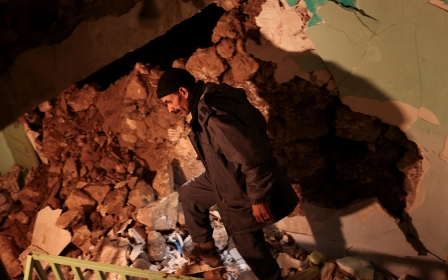In Moroccan Amazigh villages mandatory traditional homes become deathtraps

Morocco’s 6.8-magnitude earthquake, which has killed over 2,500 people since Friday, has particularly affected mud and clay houses inhabited by the indigenous Amazigh in the douars, the small villages sitting on the High Atlas mountains.
The earthquake, which struck late on 8 September, mainly affected the Ighil area of the High Atlas, some 70km from the city of Marrakech, as well as other small villages.
The earthquake is believed to be the strongest to hit Morocco in 150 years.
It has left locals in the affected area without essential supplies, including food, water and electricity, as well as shelter.
Rural communities, which are accustomed to traditional lifestyles and are largely detached from modern ways of living, have been some of the hardest hit, particularly as their homes were simple in design. Many crumbled as soon as the earthquake struck.
New MEE newsletter: Jerusalem Dispatch
Sign up to get the latest insights and analysis on Israel-Palestine, alongside Turkey Unpacked and other MEE newsletters
Locals in these traditional communities have been left awaiting help from search and rescue teams, and have called for greater support from Moroccan authorities, claiming that they have largely been neglected.
Over 300,000 people have been affected by the earthquake, according to the World Health Organization.
The immense damage caused by the earthquake has sparked criticism by the affected rural communities over building regulations and laws in some towns.
In an interview with local media, some residents said that authorities have forbidden them to build in cement, so that it doesn’t interfere with the clay and mud housing aesthetic which has become a major attraction for tourists.
“The province has suffered significant damage, particularly those in older houses," one resident told local media in an interview.
"The authorities prohibit us from building with cement. Although our houses are historic, we're not allowed to renovate them, in order to preserve their historical value and attract tourists. As you can see, all the buildings here are quite basic,” he added.
Vulnerable houses
The Amazigh people are an indigenous group from North Africa. Many of those tribes wanting to preserve their identity sought refuge in the mountains, particularly in Morocco’s Atlas and Rif regions.
Many of the douar villages have historical significance, with Douar Doukkara, which is situated in the vicinity of the ancient city of Volubilis, initially being settled by the Phoenicians and Romans over 2,000 years ago.
Today, the homes in douars are typically all built from mud bricks and blend into the sand-coloured hills behind them. Communities rely on farming and tourism, with some of the homes reachable only on foot or by mule.
Brahim el Guabli, a US-based scholar who specialises in Amazigh literature and grew up in one of Morocco’s douars, said that the houses are particularly vulnerable to any extreme weather condition, including heavy rains, but especially an earthquake.
The homes are made from heavily watered soil, which is left to rest for a few days before it is poured into moulds and pressed to tighten the bricks into a unit. The bricks, coupled with ceilings made from wood, bamboo and soil, can take months to build. This is a technique used for hundreds of years.
“Since this part of Morocco has never seen an earthquake of this magnitude, there was nothing in living memory to ever push people to give up their ancestral style of construction,” he explained.
'There was nothing in living memory to ever push people to give up their ancestral style of construction'
- Brahim el Guabli, Amazigh researcher
Guabli also stated that in the absence of assistance from the authorities, many residents of the douars have historically helped each other, and taken it upon themselves to restore parts of their village.
“Because territorial management of development projects had forgotten about these areas for a very long time, their inhabitants created a parallel, self-reliant system to take care of their needs,” he added.
"They build and maintain their roads, they have their own potable water systems, and until recently, they collectively owned electric generators to light their homes."
In many of these douars, residents rely on pistes, or dirt roads, to travel around, which have made aid efforts even more challenging.
'Forgotten Moroccans'
Meanwhile, a correspondent for the Morocco-based 2MTV channel said that many of the houses in douars are built in a “random” fashion, and would immediately collapse from any small shake.
In the small town of Amizmiz, buildings toppled in the aftershocks of the quake, with emergency response late to arrive.
Locals, some of whose families have lived in the town for over a century, told the media that “nothing was left”.
In the absence of a local hospital, the injured had to be treated at a local medical centre. However, the scale of the disaster meant that anyone in a serious condition needed to be taken to Marrakech, a trip that takes half an hour or longer, given the road blockages.
Residents of the douars typically live in small villages, and are connected through family, tribes or geographical ties. The douars elect a representative to the local community council and authorities appoint an individual to liaise between the people and key figures.
Amazigh communities have rallied to support each other, providing food where possible and joining the search for relatives and loved ones.
In Tafeghate, 60km from Marrakech, 90 of the 200 residents were confirmed dead following the quake. Many were also confirmed as missing and the town's narrow roads have been blocked by debris and large rocks.
Locals told the media that they did not have any hope that their loved ones would be dug out, and no machinery or experts had arrived at the scene.
The earthquake has almost completely wiped out some villages, particularly as some are home to just one or a few families.
In the village of Tikht, which was home to at least 100 families, homes were destroyed.
“I study architecture and in my thesis I spoke about Amazigh villages,” one social media user posted on X, formerly known as Twitter. "They look aesthetically pleasant and are eco-friendly and sustainable but they’re extremely unsafe and not adapted to present day climate change; they are the origin yet they are the forgotten Moroccans."
Ouirgane, a small town with a population of around 6,000, sits in the foothills of Morocco’s High Atlas mountains. While offering magnificent views, hiking opportunities and rivers for tourists, the town is also home to traditional clay houses which were flattened in the quake.
This article is available in French on Middle East Eye French edition.
Middle East Eye delivers independent and unrivalled coverage and analysis of the Middle East, North Africa and beyond. To learn more about republishing this content and the associated fees, please fill out this form. More about MEE can be found here.





